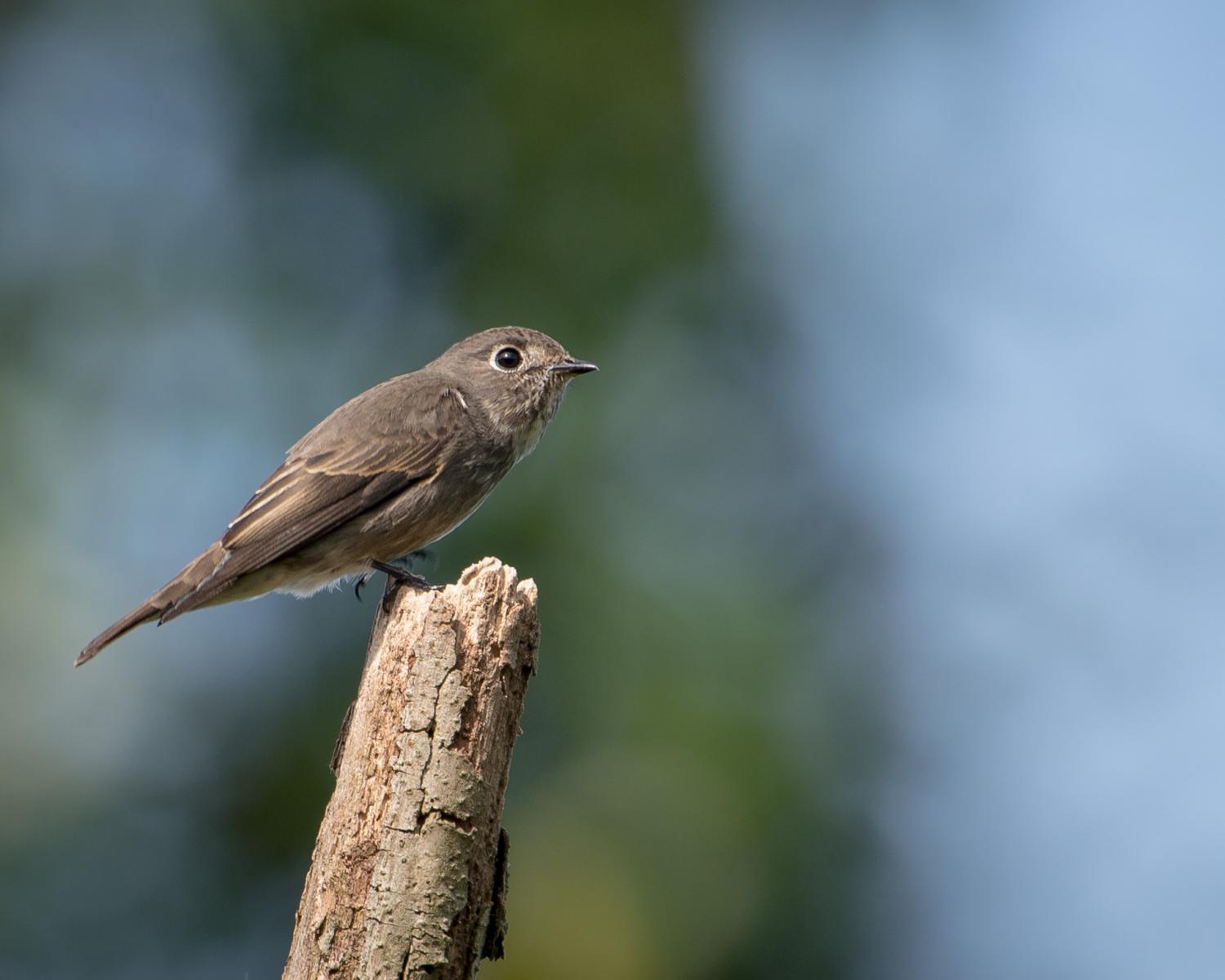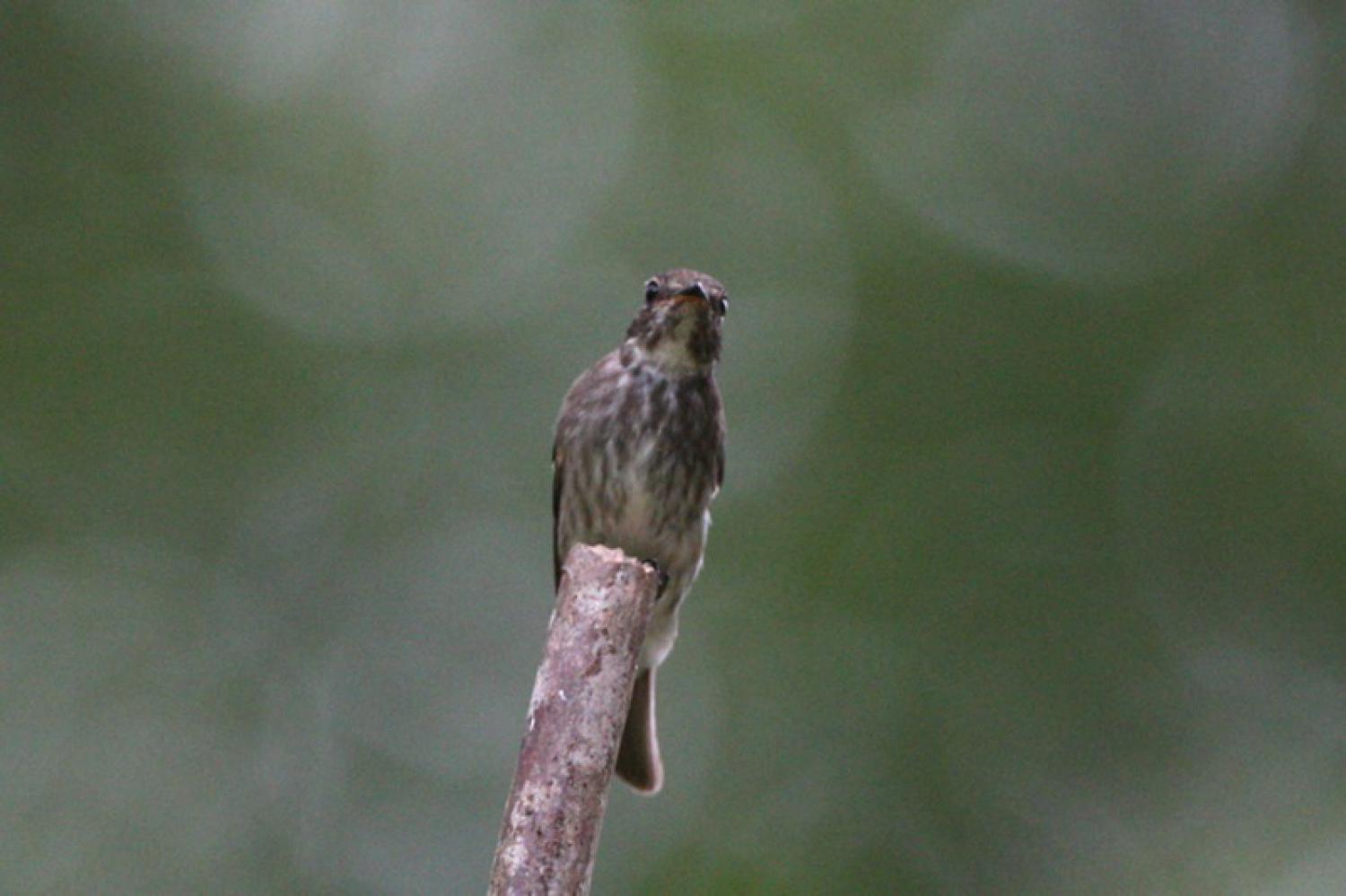Species of Thailand
Dark-sided flycatcher
Muscicapa sibirica, Johann Friedrich Gmelin, 1789
(In Thai: นกจับแมลงสีคล้ำ)
The dark-sided flycatcher (Muscicapa sibirica) is a small passerine bird belonging to the genus Muscicapa in the Old World flycatcher family Muscicapidae. It has a wide breeding distribution in the East Palearctic with northern birds migrating south for the winter. It is also known as the Siberian flycatcher or sooty flycatcher, the latter name is also used for the sooty flycatcher (M. infuscata) of Africa.
Description
It is 13 to 14 cm long. The upperparts are plain and dark grey-brown apart from a pale wingbar and pale edging to the tertial feathers. The breast and flanks have a variable amount of streaky dark grey-brown. This is unlike the similar Asian brown flycatcher which has rather plain pale underparts and the grey-streaked flycatcher which is white below with distinct grey streaks.
Dark-sided flycatchers have a pale submoustachial stripe and a dark malar stripe which outlines the white throat and half-collar. The centre of the lower breast and belly is white while the undertail-coverts are white with dark centres to the feathers. The bill is short and dark and the feet are black. The eye is large and has a whitish ring around it. The wings are long with a longer primary projection than the Asian brown flycatcher.
The adults of both sexes are alike but juveniles have pale spots on the upperparts, a mottled breast and buff tips to the wing-coverts.
The song is a series of thin, high-pitched notes with trills and whistles. The call is a metallic tinkling.
Distribution
The subspecies M. s. sibirica breeds in south-east Siberia westward to beyond Lake Baikal as well as in Mongolia, north-east China, North Korea and Japan (Hokkaidō and northern Honshū). M. s. rothschildi breeds in western China and Myanmar. M. s. gulmergi occurs from Afghanistan to Kashmir with M. s. cacabata from the eastern Himalayas to south-east Tibet and perhaps Myanmar.
The wintering range includes north-east India, Bangladesh, southern China, Taiwan and South-east Asia as far as Sumatra, Java, Borneo and the Philippines (Palawan and Culion). Vagrant birds have been recorded in Alaska, Iceland and Bermuda.
It inhabits coniferous and mixed forest and woodland and is sometimes seen in plantations, parks and gardens. It typically occurs in mountainous regions, reaching 4000 metres above sea-level in some areas.
Behaviour
Like other flycatchers, its feeding technique is to perch on an exposed branch and wait. When an insect flies past, the bird dashes out to snatch it.
It builds a cup-shaped nest 2 to 18 metres above the ground, on the branch of a tree or sometimes in a hole. Three to five eggs are laid; these are pale green with reddish markings.
This article uses material from Wikipedia released under the Creative Commons Attribution-Share-Alike Licence 3.0. Eventual photos shown in this page may or may not be from Wikipedia, please see the license details for photos in photo by-lines.
Category / Seasonal Status
Wiki listed status (concerning Thai population): Winter visitor
BCST Category: Recorded in an apparently wild state within the last 50 years
BCST Seasonal status: Non-breeding visitor
Scientific classification
- Kingdom
- Animalia
- Phylum
- Chordata
- Class
- Aves
- Order
- Passeriformes
- Family
- Muscicapidae
- Genus
- Muscicapa
- Species
- Muscicapa sibirica
Common names
- English: Dark-sided flycatcher
- Thai: นกจับแมลงสีคล้ำ
Conservation status

Least Concern (IUCN3.1)
Photos
Please help us review the bird photos if wrong ones are used. We can be reached via our contact us page.
Range Map

- Bang Phra Non-Hunting Area
- Bang Pu Recreation Centre
- Bangkok Province
- Chiang Dao Wildlife Sanctuary
- Doi Inthanon National Park
- Doi Lang
- Doi Lo District, Chiang Mai
- Doi Pha Hom Pok National Park
- Doi Phu Kha National Park
- Doi Suthep - Pui National Park
- Hala-Bala Wildlife Sanctuary
- Hat Chao Mai National Park
- Kaeng Krachan National Park
- Kamphaeng Saen District, Nakhon Pathom
- Khao Dinsor (Chumphon Raptor Center)
- Khao Khitchakut National Park
- Khao Laem National Park
- Khao Laem Ya - Mu Ko Samet National Park
- Khao Lak - Lam Ru National Park
- Khao Luang National Park
- Khao Phra - Bang Khram Wildlife Sanctuary
- Khao Pu - Khao Ya National Park
- Khao Sam Roi Yot National Park
- Khao Soi Dao Wildlife Sanctuary
- Khao Sok National Park
- Khao Yai National Park
- Khlong Lan National Park
- Khon San District, Chaiyaphum
- Khun Nan National Park
- Klaeng District, Rayong
- Ko Chang National Park
- Kui Buri National Park
- Laem Son National Park
- Mae Ai District, Chiang Mai
- Mae Moei National Park
- Mae Wong National Park
- Mueang Chiang Mai District, Chiang Mai
- Mueang Chiang Rai District, Chiang Rai
- Mueang Chumphon District, Chumphon
- Mueang Khon Kaen District, Khon Kaen
- Mueang Krabi District, Krabi
- Mueang Nonthaburi District, Nonthaburi
- Mueang Phang Nga District, Phang Nga
- Mueang Samut Sakhon District, Samut Sakhon
- Mueang Surin District, Surin
- Nam Nao National Park
- Namtok Sam Lan National Park
- Pak Phanang District, Nakhon Si Thammarat
- Pang Sida National Park
- Phu Chong Na Yoi National Park
- Phu Foi Lom National Park
- Phu Hin Rong Kla National Park
- Phu Langka National Park
- Phu Luang Wildlife Sanctuary
- Phu Suan Sai National Park
- Phu Wiang National Park
- Phutthamonthon District, Nakhon Pathom
- Sai Yok National Park
- Samae San Island
- Samut Prakan Province
- Sattahip District, Chonburi
- Sikao District, Trang
- Sri Phang-nga National Park
- Tat Mok National Park
- Thai Mueang District, Phang Nga
- Thale Ban National Park
- Thung Yai Naresuan Wildlife Sanctuary
- Ton Nga-Chang Wildlife Sanctuary
- Ton Pariwat Wildlife Sanctuary
- Wang Mai Forest Restoration Project

